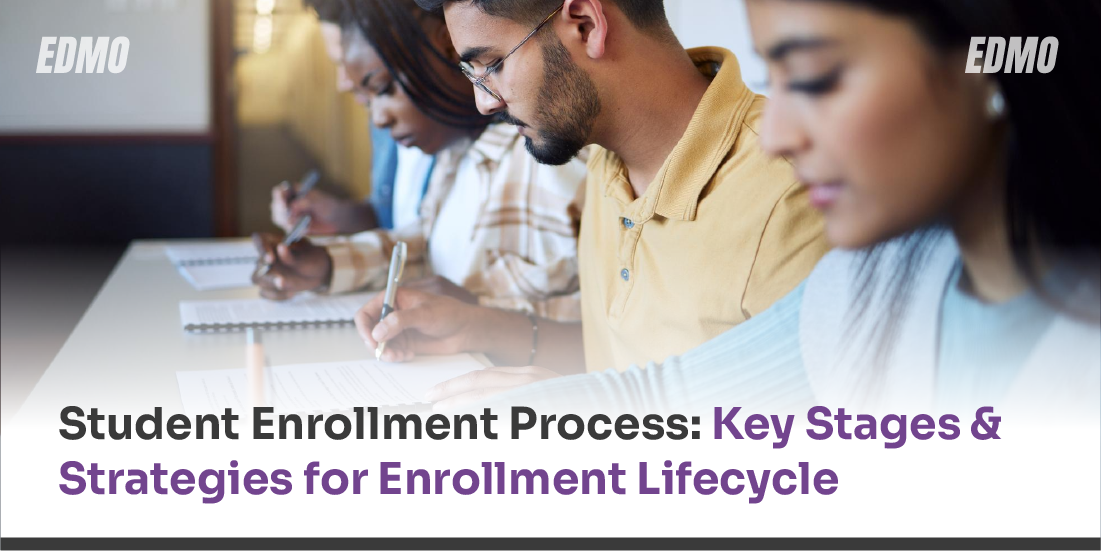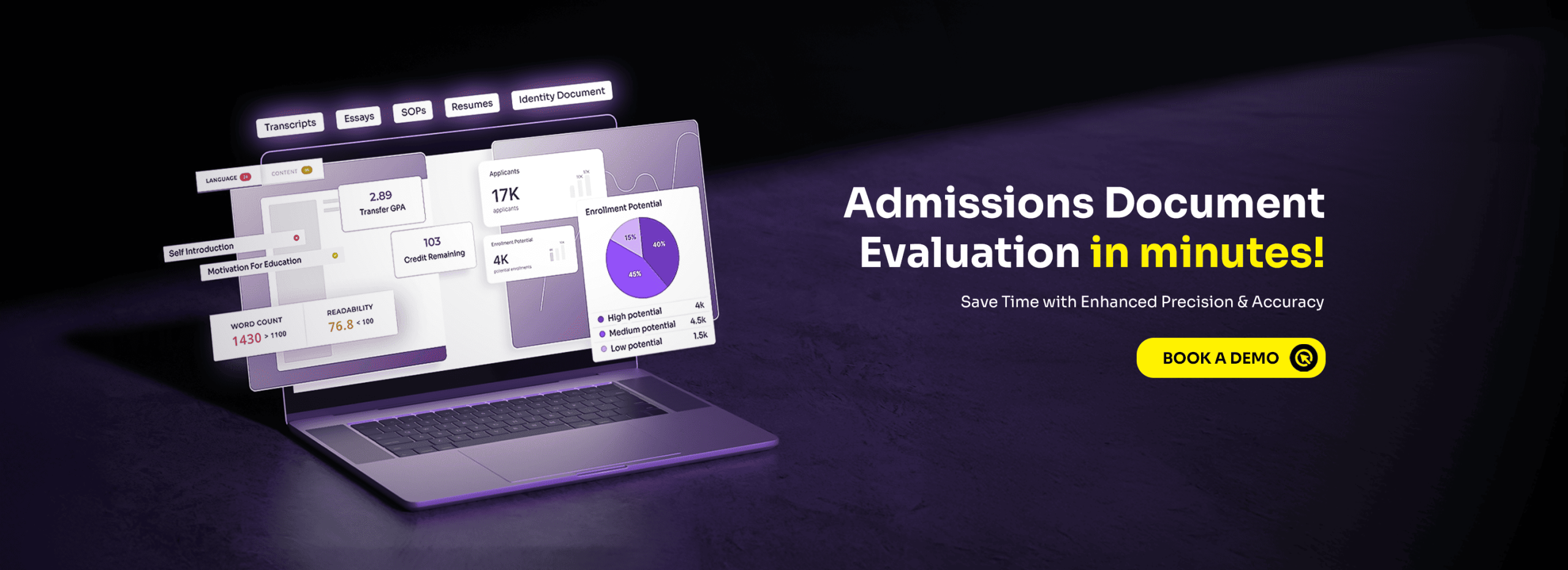Table Of Contents
- 1Introduction
- 2How does the Enrollment Process Work?
- 3What’s the importance of managing the Enrollment Process?
- 4Advantages of the Digital Enrollment Process
- 56 Ways to Make the New Student Enrollment Process Easier
- 6Challenges of the Enrollment Process
- 7How can you optimise the Enrollment Process?
- 8Summary
Introduction
The enrollment process is the series of steps a student follows to officially join a school, college, or university. It begins when a student shows interest in an institution and ends when they are formally registered and ready to start classes. It is a dynamic, multi-stage journey, from initial inquiry to post-graduation engagement—demanding an intentional, data-driven approach. It typically follows several key phases: inquiry, application start, application submission, admission, and enrollment. Once enrolled, students advance through engagement, academic progression, graduation, and eventually alumni involvement and outreach. This lifecycle model underscores the institution’s responsibility at every touchpoint—from a campus tour or social media post to FAFSA support and graduation ceremonies.
Recent trends underscore the urgency of optimising this process. In the U.S., college enrollment has dropped by about 5% for 18-year-old first-year students this fall, with Black first-year students’ enrollment declining nearly 17%—even while applications rose 7% among low- and middle-income students. Conversely, Western Connecticut State University (WCSU) reported a 6.2 % increase in first‑year enrollment and an 11 % rise in transfer students this fall, alongside a 3 % gain in freshman retention—highlighting how focused strategies can yield positive outcomes.
In this context, institutions must integrate robust strategies—leveraging enrollment funnels, data analytics, communications, and financial aid—to not only attract but retain and support students throughout their academic lifecycle.
How does the Enrollment Process Work?

The enrollment process in higher education is the structured journey students take from first showing interest in a college or university to becoming officially enrolled. It is not a single step but a series of interconnected stages that involve awareness, application, admission, and registration. Each stage is critical for institutions, as it directly impacts conversion rates, retention, and overall student success. With today’s competitive landscape and declining enrollment trends in many regions, understanding the enrollment process helps universities create personalised strategies to attract, engage, and retain students effectively.
Key Stages of the Enrollment Process:
Awareness & Inquiry
This is the starting point where a student first learns about a college or university. Awareness comes through multiple channels—digital marketing campaigns, social media, high school counsellors, alumni, or campus visits. At this stage, institutions focus on building brand value and capturing student interest. For example, a strong virtual campus tour or responsive admissions chatbot can turn curiosity into an official inquiry. According to Carnegie Dartlet’s enrollment research, over 65% of students say a university’s website is their first stop when researching colleges.
Application Initiation
Once interested, students begin filling out applications. They may use common portals (e.g., the Common App) or institutional applications. Here, deadlines, program relevance, and financial aid opportunities play a critical role. Universities often provide webinars, FAQs, and direct counsellor support to guide students through the process.
Application Submission & Review
After submission, the admissions office evaluates academic records, recommendation letters, essays, test scores (if required), and extracurricular. Many institutions now use holistic admissions models—for example, the University of California system dropped standardised test requirements, shifting focus to GPA, essays, and personal achievements.
Admission Decision
Applicants receive acceptance, rejection, or waitlist status. This stage requires timely, transparent communication. For example, some universities provide real-time application status portals that keep students engaged and reduce anxiety.
Financial Aid & Offers
Cost is one of the most significant deciding factors. Students receive details about scholarships, grants, and loan options. According to NCES, over 84% of full-time undergraduate students receive some form of financial aid. A clear aid package can significantly influence enrollment decisions.
Enrollment Confirmation
Admitted students confirm intent by paying deposits and completing forms. Institutions track “yield rate”—the percentage of admitted students who actually enroll. Nationally, the average yield is 33–35% (IPEDS data), though top-tier schools may see higher rates.
Registration & Orientation
Finally, students complete course registration, housing selection, and attend orientation sessions. This stage is crucial for retention: research by NACADA shows that students who attend structured orientation programs are more likely to persist into their second year.
What’s the importance of managing the Enrollment Process?
Managing the enrollment process is critical for both students and institutions. For students, a smooth and transparent process ensures confidence, timely decisions, and a positive start to their academic journey. For schools and universities, effective enrollment management directly impacts student satisfaction, retention rates, and institutional revenue. In an era where U.S. higher education enrollment has declined by nearly 5% over the past five years (National Student Clearinghouse, 2023), institutions must view enrollment not just as an administrative task but as a strategic function that secures long-term growth and success.
Importance of Managing the Enrollment Process:
Improves Student Experience
A seamless enrollment process ensures that students don’t feel overwhelmed during one of the most critical transitions in their lives. Clear instructions, online forms, and timely communication reduce confusion and build confidence. For instance, universities that offer self-service online enrollment portals allow students to complete applications in minutes rather than days, creating a positive first impression.
Boosts Enrollment & Retention Rates
Managing enrollment well doesn’t just bring students in—it helps keep them. Institutions with structured onboarding and orientation programs see higher retention. For example, NACADA research highlights that students who attend comprehensive orientation sessions are more likely to return for their second year. Similarly, Western Connecticut State University (WCSU) saw a 6.2% increase in first-year enrollment and an 11% rise in transfer students in 2024 after strengthening its enrollment and retention strategies.
Enhances Institutional Reputation
When students experience a smooth, transparent process, they share positive feedback with peers and families. This boosts the institution’s reputation and attracts future applicants. On the flip side, a confusing or delayed enrollment process can lead to frustration, negative reviews, and lost applicants. For example, schools that use chatbots and AI-driven communication tools to answer student queries 24/7 have reported higher satisfaction rates among incoming students.
Supports Data-Driven Decisions
Enrollment is also about data. Institutions that actively track application numbers, yield rates, and demographic patterns can forecast demand, adjust financial aid packages, and plan courses. For example, using predictive analytics, Arizona State University identifies at-risk students during enrollment and provides targeted support to improve their success. Effective data use helps universities allocate faculty, housing, and resources efficiently, reducing bottlenecks.
Ensures Compliance & Transparency
Proper enrollment management ensures all requirements—such as eligibility, document verification, and government regulations—are met. This protects both students and institutions from legal or accreditation issues. For example, K–12 schools like Method Schools in California ensure compliance by restricting enrollment to eligible counties and prohibiting concurrent enrollment in other schools. Clear policies and transparent communication also build trust with families and regulators.
Advantages of the Digital Enrollment Process
The digital enrollment process has transformed how schools, colleges, and universities manage admissions. Unlike traditional paper-based systems, digital enrollment is faster, more efficient, and provides a seamless experience for both students and institutions. With the rise of online applications, e-signatures, document uploads, and automated communication, institutions can handle larger volumes of applicants while reducing errors and administrative workload. For students, it means greater convenience, transparency, and flexibility in securing admission. According to the National Centre for Education Statistics (NCES), nearly 90% of U.S. colleges now accept online applications, highlighting how digital-first enrollment has become the new standard.
Advantages of the Digital Enrollment Process for the Education Institution
- Operational Efficiency – Digital systems reduce manual paperwork, cut processing times, and lower administrative costs.
- Data Accuracy & Security – Automated systems reduce human error and store student records securely with audit trails.
- Scalability – Institutions can manage thousands of applications simultaneously, even during peak admission seasons.
- Data-Driven Insights – Analytics tools track applicant trends, helping in strategic decision-making and resource allocation.
- Enhanced Communication – Automated emails, chatbots, and portals ensure consistent, timely updates to applicants.
- Eco-Friendly – Reduces the use of paper, printing, and mailing, supporting sustainability goals.
Advantages of the Digital Enrollment Process for Students
- Convenience & Speed – Applications can be completed anytime, anywhere, often in under 15 minutes.
- Transparency – Students can track their application status in real-time through online portals.
- Accessibility – Digital forms and mobile-friendly systems make enrollment easier for diverse student populations.
- Cost Savings – Eliminates postage, travel, and physical form costs.
- Reduced Stress – Automated reminders for deadlines and document uploads ensure students don’t miss critical steps.
- Faster Decisions – With instant document submission and review, students receive admission updates quickly.
6 Ways to Make the New Student Enrollment Process Easier

The enrollment journey can often feel overwhelming for new students and their families. By simplifying steps, enhancing communication, and leveraging digital tools, institutions can create a smoother, faster, and more supportive process that builds trust and improves student satisfaction.
Offer a User-Friendly Online Portal
A smooth digital experience is the foundation of modern enrollment. Students should be able to submit applications, upload documents, pay fees, and track progress all in one portal. A mobile-friendly interface ensures accessibility across devices. For example, the Common App allows millions of students worldwide to apply to multiple institutions through a single, simple platform.
Streamline Required Documents
Too much paperwork often causes delays and stress. Institutions can simplify the process by creating a clear checklist of required documents (transcripts, ID, test scores, etc.) and enabling direct digital uploads. Some universities also use document intelligence tools to scan and verify records instantly, reducing manual reviews and errors.
Automate Reminders & Notifications
Missed deadlines are a common reason students fail to enroll. By sending automated reminders via email, text, or app notifications, institutions can keep students updated about due dates, missing documents, or orientation schedules. According to EAB research, personalised text reminders can increase enrollment yield by up to 7%.
Provide Step-by-Step Guidance
Many students, especially first-generation applicants, find the enrollment process confusing. Institutions can provide how-to guides, explainer videos, or webinars that walk students through each step. For example, some universities host virtual workshops on FAFSA completion, ensuring students don’t miss out on financial aid opportunities.
Enhance Personalised Support
Every student’s journey is unique, so institutions should offer both AI-driven chatbots for instant answers and human enrollment specialists for complex queries. Schools like Georgia State University use predictive analytics and proactive advising to reach out to at-risk students, significantly improving enrollment and retention rates.
Simplify Orientation & Registration
Combining orientation, academic advising, and course registration into one seamless experience makes the transition smoother. Many institutions now host virtual orientation programs where students meet peers, register for classes, and connect with advisors in a single session. Research by NACADA shows that students who attend structured orientation are more likely to persist into their second year.
Challenges of the Enrollment Process
Managing the enrollment process comes with several challenges that impact both educational institutions and prospective students. These obstacles—ranging from application complexity and financial hurdles to technological limitations and demographic shifts—can delay enrollment, lower engagement, and complicate strategic planning.
Complexity and Perceived Bias in Admission
The admission process is often criticised for being overly complicated and opaque. Many students and families struggle with understanding requirements, deadlines, and evaluation criteria. According to a NACAC survey, 77% of young adults find the college admission process confusing, while 74% believe it is biased in favour of wealthy applicants. This perception not only deters students from applying but also erodes trust in institutions.
Demographic Shifts and Declining Enrollment
The U.S. is facing what’s often called the “enrollment cliff”—a long-term decline in the number of college-aged students due to lower birth rates. Since 2020, undergraduate enrollment has dropped by 1.09 million students. This trend is forcing universities to rethink recruitment strategies and expand outreach to nontraditional and international students.
Financial Aid Delays Impacting Student Persistence
Financial barriers remain one of the biggest obstacles in higher education. Delays in FAFSA processing and financial aid approvals often discourage students from enrolling or continuing their studies. A BestColleges survey revealed that 1 in 4 students faced enrollment challenges due to financial aid delays. Community colleges, in particular, saw FAFSA completion rates fall by 3.9% between 2019 and 2021, which correlated with enrollment declines.
Data Fragmentation and Analytics Challenges
Many institutions store data across multiple systems—CRM, SIS, and LMS platforms—which prevents a unified view of applicants. This fragmentation makes it harder to forecast enrollment or personalise outreach. Without integrated analytics, universities risk losing applicants who “melt” before registration. Institutions adopting predictive modelling have improved enrollment forecasting accuracy by up to 12%, enabling better yield strategies.
Intense Competition and Rising Application Volumes
With test-optional policies and platforms like the Common App, application numbers are rising while acceptance rates plummet. This increases pressure on students and makes admissions offices’ jobs harder. For example, selective colleges reported record-high applications in 2024, making it feel “near impossible” to get admitted.
Overcrowding and Resource Constraints
Some colleges face the opposite problem: too many applicants and not enough resources. Austin Community College experienced a 15% surge in enrollment (4,600 new students), which left 5,800 students on waitlists due to class shortages. Institutions in similar situations must scramble to hire adjuncts or expand capacity.
High Dropouts in K–12 Enrollment
Across the United States, public K–12 enrollment has fallen significantly, by over 1.2 million students between fall 2019 and fall 2023, according to NCES data. This marks an approximate 2.5% decline, the steepest drop in decades. These losses are driven by demographic changes, such as falling birth rates, and a clear shift toward school choice alternatives—charter schools, private institutions, and homeschooling—that gained popularity during and after the COVID‑19 pandemic.
Institutional and Technological Glitches
As schools and universities modernise with digital enrollment tools, technical failures remain a significant hurdle. Several states have experienced K–12 portal crashes during peak enrollment periods, preventing families from securing timely spots—especially in charter or magnet schools. Similarly, university admissions portals sometimes crash under high traffic, delaying decisions and causing frustration for both students and administrators. These disruptions highlight the need for reliable, scalable technology in modern enrollment systems.
How can you optimise the Enrollment Process?
Optimising the enrollment process is essential for improving student experience, increasing conversion rates, and reducing institutional inefficiencies. A streamlined, transparent, and data-driven process helps attract more students, minimise drop-offs, and enhance long-term retention. With growing competition and demographic shifts (the National Student Clearinghouse reports U.S. undergraduate enrollment has dropped by 1.09 million since 2020), institutions must focus on making enrollment smoother, faster, and more personalised.
Adopt a Centralised Online Portal
Students often feel lost when they have to visit multiple websites, download different forms, and follow long instructions. A centralised online portal brings everything together—applications, documents, payments, and progress updates—in one place. This not only saves time for students but also reduces confusion. Institutions benefit too, since staff can monitor and support applications more effectively through one system.
Simplify Documentation Requirements
A long list of forms and paperwork can discourage students from completing enrollment. Schools and universities can make things easier by keeping requirements clear and straightforward, and by allowing students to upload digital copies instead of mailing or bringing documents in person. When the process feels straightforward, students are less stressed and more likely to complete it on time.
Leverage Automation & AI
Students often miss deadlines simply because they forget or don’t get timely reminders. Automated systems can send alerts for upcoming deadlines, missing documents, or important meetings. Chatbots can also answer common questions instantly, which saves students from waiting for office hours or email replies. This makes the whole process smoother and faster for everyone involved.
Personalise Communication
Every student is different, and a one-size-fits-all approach can feel impersonal. Schools can send messages tailored to the student’s chosen program, interests, or stage in the process. For example, a student applying to a business program could receive updates about career opportunities or alumni success stories in that field. Personalised communication makes students feel valued and supported, building stronger trust with the institution.
Enhance Financial Aid Transparency
Finances are one of the biggest concerns for students and their families. Many feel anxious when costs aren’t explained clearly. By providing simple, easy-to-read details about scholarships, grants, and payment options, institutions can help families make informed decisions. When students know exactly what they need to pay and what support is available, they can plan better and feel more confident about enrolling.
Offer Virtual Support & Orientation
Not every student can travel to campus before classes begin. Virtual support, such as online tutorials, live Q&A sessions, and digital orientation programs, gives students a chance to learn about the school, meet advisors, and prepare for their courses from anywhere. This helps them feel included and ready to start, even before they arrive on campus.
Track & Analyse Process Steps
Sometimes, students drop out of the enrollment process because they get stuck at certain stages—like uploading documents or making payments. By tracking where students face the most challenges, institutions can identify weak spots and improve them. Over time, this continuous improvement makes the entire process smoother and more reliable for future students.
Ensure Mobile Accessibility
Today’s students rely heavily on their phones for nearly everything—browsing, applying, and communicating. If the enrollment system is not mobile-friendly, many students may find it frustrating or even give up. Ensuring that portals and forms work well on smartphones makes the process more flexible, letting students complete tasks anytime, anywhere. This small step can have a significant impact on enrollment success.
Summary
The enrollment process is more than just filling out forms—it’s the first real step a student takes toward their educational journey. From the moment they show interest in a school to the day they attend orientation, every stage matters. A smooth process helps students feel supported, confident, and excited about what lies ahead, while a confusing one can create stress and uncertainty. For schools, enrollment isn’t just about numbers—it’s about building trust, guiding students through important decisions, and setting them up for long-term success. Digital tools have made this journey easier by cutting down paperwork, sending timely reminders, and giving students the freedom to apply anytime, anywhere. But challenges like financial hurdles, high competition, and technical issues remain. By focusing on clear communication, personalised support, and simple, student-friendly systems, institutions can make enrollment a positive experience that sparks motivation and belonging from the very start.










Nice and insightful blog.